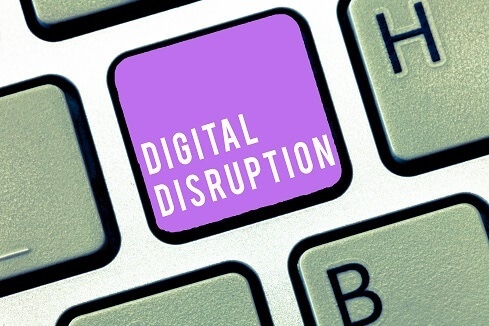Digital disrupters have changed the rules of competitiveness. Savvy enterprises are paying close attention.

Digital disruption continues to change industries. Companies are moving further into the cloud, they've become more agile, and they're obsessed about customer experience. Digital companies realize those aren't innovative traits anymore, they're tables stakes.
“The biggest differentiator is that can-do attitude and the ability to get stuff done in contrast to losing yourself in beautiful visual concepts, frameworks and go-to-market strategies, and engaging with all these strategy consultants for a six-month engagement, and they build beautiful slides,” says Bernhard Schaffrik, principal analyst at Forrester. “If employees find out this is just pleasing investors or window dressing for marketing efforts, they'll leave.”
It's one thing to sound like the disrupters and quite another to behave like them. The result can be a great sounding story that lacks substance.
“CEOs are supposed to be held accountable for nothing getting done. As long as the short-term results and growth rate are good enough [they can get away with it], but that's basically a kind of credit they're consuming from the company's future,” says Schaffrik. “A couple of years later, you see all these big companies struggling, and they have to fire people, and they have to get rid of certain brands. And these brands are then purchased by digital powerhouses who are going to digitalize them, and that's a shame.”
Transform Concepts into Action
One key trait the digital disrupters share is their propensity to move quickly. While Mark Zuckerberg's “move fast and break things” mantra isn't appropriate for every company, organizations must be willing to take risks. While Amazon, Facebook, and Google have succeeded at many things, they've also failed miserably along the way. They realize the price of innovation is occasional failure and the lessons learned from it.

Bernhard Schaffrik, Forrester
“In some cases, you actually need to exchange top management for people who embrace giving up control to a certain extent, who are willing to take risks, including with their annual bonuses,” says Schaffrik. “If leaders embrace risk and experimentation that's going to spread across the company.”
Operating in today's climate means updating mindsets, processes, budgeting cycles, incentive systems and traditional ways of working. It's not about ping pong tables and arcade rooms. It's being better at delivering on core competencies than competitors and having the digital savviness required to succeed in a digital-first world. However, the most valuable trait is curiosity because curiosity leads to experimentation, innovation, optimization, and learning.
“Disruptors face the challenge of explaining the concept and the benefits of the new approach. Many organizations struggle to grasp it and operate under the inertia of business as usual,” says Greg Brady, founder and chairman of supply chain control tower provider One Network Enterprises. “The COVID-19 pandemic has opened the eyes of many executives to the shortcomings of the old way of doing business.”
Some organizations attempt to mimic what the digital disrupters do. However, their success tends to depend on the context in which the concept was executed.
For example, Zappos disrupted ecommerce by offering free returns as well as free shipping. One can order as many pair of shoes as they'd like and return all of them -- free -- while having the opportunity to try the shoes on in the comfort of their own home. By introducing that policy, Zappos provided customers with a new level of convenience and lowered the buyer's risk. However, Zappos merchandise pricing is often higher than competitive sites. What some copycats learned the hard way is that free shipping and returns need to be built into the sales price of the product, which is difficult to do if the business is known for below-market pricing.
HomeRoots Was Inspired by Amazon
B2B wholesale platform HomeRoots learned three things from Amazon, the first of which was faster merchandise delivery equates to higher customer satisfaction.
“Amazon Prime building their logistical network independently from others has made their delivery service second to none and a source for inspiration to many other retail and e-commerce businesses,” says Gil Bar-Lev, CEO, and founder of HomeRoots. “We are building our own logistical network in such a way that we offer faster delivery than what's currently available in the industry from other wholesalers and manufacturers.”
Bar-Lev and his team also adopted Amazon's marketplace strategy, which is to the number and types of products it sells through third-party sellers and that many retailers have adopted. Among them, Costco, Walmart and HomeRoots.
“The major difference here is that we are dealing with the manufacturers directly and less with other retailers selling on Amazon. By [doing] that, we can offer deeper discounts on the items and within time even offer an even greater portfolio of products,” says Bar-Lev.

Gil Bar-Lev, HomeRoots
Finally, Amazon taught HomeRoots what not to do, which is to treat third-party sellers badly.
“You often hear sellers complaining about the way that Amazon treats them, whether it's with always choosing the customer's side in disputes or asking sellers [to jump] through hoops to provide evidence to claims made by Amazon Bots, claims that often have no basis and make no sense,” says Bar-Lev. “We don't rely solely on bots. We minimize the interactions with the manufacturers and handle the majority of the customer's claims on our own. By the time we reach out to a manufacturer, a human being already reviewed the information and common sense was applied. We reduce the risks of selling and provide higher stability.”
In the future, the company will also offer product warranties.
vEvents Was Inspired by Zoom
Videoconferencing isn't a new concept and Zoom didn't invent it. However, Zoom is the go-to video call platform in 44 countries according to a survey by EmailToolTester. It has 55% market share in the US and UK. It used to be enterprises had to buy expensive equipment for video conferences. Zoom has a starter option that's free.
“Digital disruption is changing everyday lives -- the way we work, connect with family and loved ones, and even how we get involved with causes,” says Muhammad Younas, CEO and Founder of vFairs. “Being in the right place isn't enough. You need to back it up with a scalable, easy-to-use product, linear pricing, and quality customer service. Zoom bought that in spades when the pandemic hit.”
Still, virtual events, whether they're webinars or virtual conferences and exhibitions, are suffering from poor attendance. Part of the problem is keeping people engaged online when distractions are a swipe, tap, or mouse click away. The other problem is that many organizations have not figured out how to translate the physical events they produced for years into a digital equivalent, nor have they tried reimaging the event entirely. vEvents employs a full project team to ensure its customers have a successful virtual or hybrid event.
“You can’t differentiate based on product and tech for long. Today's novel feature will become tomorrow’s commodity,” says Younas, “Customer service, empathy, and trust will remain the secret sauce in maintaining business along with a strong, progressive product. [All] are necessary and each is not sufficient without the other.”
The Pandemic Accelerated Digital Transformation
The COVID-19 pandemic forced companies to accelerate their digital transformation initiatives. The ones that couldn't pivot fast enough lost precious momentum or failed completely.
“Brands have had to create more direct relationships with their customers and have been faced with the unique opportunity to dig deeper into customer experience and, in turn, how purchase decisions are impacted by a brand’s digital reputation,” says Grant McDougall, CEO and Co-Founder of brand intelligence platform BlueOcean. “Many brands are moving towards a [direct to consumer] model, including the largest retailer-driven companies such as P&G, Unilever and AB Inbev. We even see this shift in experience happening in B2B.”
Customer experience principles are still developing in many verticals, however.
“The companies that can understand and respond in near real-time to competitive and ecosystem changes will be the winners,” says McDougall. “[To accomplish that,] companies need a good process built on interaction, testing and failing quickly. More importantly, it requires interdisciplinary thinking and higher levels of collaboration and communication.”
Related Content:
10 Digital Transformation Mistakes to Avoid
About the Author(s)
You May Also Like







